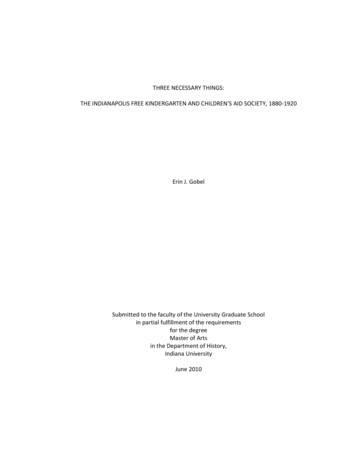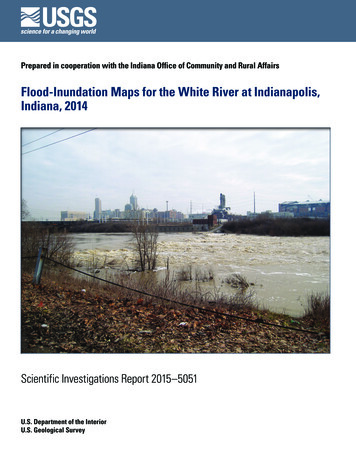
Transcription
THREE NECESSARY THINGS:THE INDIANAPOLIS FREE KINDERGARTEN AND CHILDREN’S AID SOCIETY, 1880-1920Erin J. GobelSubmitted to the faculty of the University Graduate Schoolin partial fulfillment of the requirementsfor the degreeMaster of Artsin the Department of History,Indiana UniversityJune 2010
Accepted by the Faculty of Indiana University, in partialfulfillment of the requirements for the degree of Master of Arts.Anita Morgan, Ph.D., ChairRobert G. Barrows, Ph.D.Master’s ThesisCommitteeDaniella J. Kostroun, Ph.D.ii
ACKNOWLEDGMENTSI owe numerous people thanks for their help with this project. First, I would like to thankmy thesis chair, Anita Morgan, who has been encouraging and supportive. She has always beenexcited about my project. The other members of my committee, Bob Barrows and DaniellaKostroun, have been helpful by providing many suggestions, which only made my project better.I owe a special thank you other members of the IUPUI History faculty. First, to NancyRobertson, who helped me to develop a paper entitled “‘To Weld the Home and Kindergarteninto a Closer Union’: The Mothers’ Groups of the Indianapolis Free Kindergarten and Children’sAid Society, 1878-1915.” This paper eventually became a chapter of my thesis. Annie Colemanwas an incredible help at the very beginning of this process, helping to locate secondary sourcesand plan the project.I would also like to thank the library staff at the Indiana Historical Society and the staffat the Indiana State Library for their help with my numerous research requests.Finally, to the members of my family, thank you for being so supportive throughout mywhole graduate school experience. Most of all, I owe a huge thank you to my husband, Kyle. Inever could have done this without your love and support.iii
CONTENTSIntroduction . 1Chapter OneTraining Women to be Teachers and Mothers: The Indianapolis Normal Training School . 17Photographs . 45Chapter TwoTraining Children for the Future: The Kindergartens . 46Photographs . 75Chapter ThreeTraining Mothers to be Better Mothers: The Mothers’ Programs . 76Mothers’ Council Notes. 103Conclusion . 104Bibliography . 108Curriculum Vitaeiv
There are three things necessary:First, that the teachers shall be trained;second, that the children shall be trained;third, that the parents shall be trained.11Ida A. H. Harper, The Associated Work of the Women of Indiana (Indianapolis: Wm. H. Burford, 1893), 14.v
INTRODUCTIONIn September 1885, Onis Williams, a “very bright colored boy” kept running away fromhis home in Indianapolis to attend classes at the nearby kindergarten. Onis’ clothingembarrassed his mother, a hard-working woman whose husband abandoned her five yearsbefore. Although she took in washing and ironing, she could not provide better clothes for Onis.She forbade him to go to the kindergarten dressed in “rags,” but every day, Onis ran off to theschool.Fortunately for Onis, Nettie Duzan, a Friendly Visitor for the Indianapolis FreeKindergarten and Children’s Aid Society, soon appeared at his mother’s door. Nettie broughtOnis two sets of underclothes, pants, a coat, and two shirtwaists. In November, Nettie broughtOnis a pair of much needed shoes. Nettie recorded that “the boy has now been completelyclothed by us but the clothing is kept clean and the new pride and self-respect of the boy repayour care.” Onis, with his mother’s permission, attended kindergarten “clean and bright everyday.”2***A group of well-to-do women formally organized the Indianapolis Free Kindergarten andChildren’s Aid Society with the goal to open kindergartens for children like Onis Williams.3Reverend Oscar C. McCulloch, a social gospel proponent, was influential in organizing these2“Friendly Visitor Records 1885-1891,” Indianapolis Free Kindergarten and Children’s Aid Society Records1884-1972, Bound Volume 1510, Manuscripts and Visual Collections, Indiana Historical Society,Indianapolis, Indiana, September 1-November 7, 1885, pp. 31, 35-36. In the collection guide, thisparticular bound volume is listed as “Reports of the Superintendent.” These records are actually monthlyreports from the Friendly Visitors. I have used “Friendly Visitor Records” throughout.3The Children’s Aid Society was founded in 1881 and affiliated with the Charity Organization Society inIndianapolis. In 1884, the Indianapolis Free Kindergarten and Children’s Aid Society was incorporated bylaw. Later, in 1927, the organization dropped Children’s Aid Society from its name. See Indianapolis FreeKindergarten Society, Indianapolis Free Kindergarten Society 1882-1942 (Indianapolis: Indianapolis FreeKindergarten Society, 1942), 23.1
women as well as several other Indianapolis charitable organizations.4 The clubwomen of theIndianapolis Free Kindergarten and Children’s Aid Society collected funds and goods from localbusinesses and wealthy businessmen to support their work; the clubwomen also hosted teas,parties, and an annual ball to raise money. At first, the women of the Indianapolis FreeKindergarten and Children’s Aid Society (hereafter IFK) opened kindergartens and distributedclothing to young children in the poorest districts of the city. Over time, however, IFK expandedto include adult programs, programs for children of all ages, and opened a teachers’ trainingschool.Studies of Progressive reform have largely concentrated on New York City and Chicago,while smaller cities, such as Indianapolis, have been ignored. Robert Barrows, author of a recentbiography of a notable Indiana reformer, Albion Fellows Bacon, contends that “smaller citieswere also important in the overall process of urbanization.” Barrows continues,*i n 1900 a slightly larger number of the country’s urban residents lived in citiessmaller than 100,000 than in places of 100,000 or more. Although oftenoverlooked, Dayton, Terre Haute, Peoria, and the like were as representative ofthe nation’s urban experience as were the much more frequently examinedNew York, Philadelphia, and Chicago.5This thesis will show that women in Indianapolis, a second-tier midwestern city, built anationally recognized, sustainable, and important system of kindergartens beginning in the4Genevieve Weeks explains that McCulloch “was an early advocate of the movement for social justicewhich later became known as the Social Gospel, in which the teachings of Jesus were held to beapplicable to all facets of society—to the economic and social order as well as to the individual. While itsprinciples and practices were disseminated more widely in the preaching and writings of others—Washington Gladden, Josiah Strong, Richard T. Ely, Walter Rauschenbusch—McCulloch was the mosteffective and influential exponent of this movement in Indiana and thus contributed to its early growthand development.” See Genevieve C. Weeks, Oscar Carleton McCulloch: 1843-1891: Preacher andPractitioner of Applied Christianity (Indianapolis: Indiana Historical Society, 1976), xv. Allen F. Davisdescribes the impulse for reform as “related to the desire to apply the Christian idea of service to the newchallenges and the new problems of the city.” See Allen F. Davis, Spearheads for Reform: The SocialSettlements and the Progressive Movement 1890-1914, 2d edition (New Brunswick: Rutgers UniversityPress, 1984), 29.5Robert G. Barrows, Albion Fellows Bacon: Indiana’s Municipal Housekeeper (Bloomington: IndianaUniversity Press, 2000), xv.2
1880s that ultimately became the basis for kindergartens in the Indianapolis Public Schools inthe 1950s.***Karen Blair argues that the woman’s club was “a realm in which proper ladiesflourished,” although many may have been “feminists under the skin.” Blair explains that theideology of the lady was “the belief that every woman was a moral and domestic creature whoembodied the desirable traits of loving maternity, intuition, and sensitivity.”6 Often elitemembers of the community, IFK clubwomen certainly would have considered themselves to beladies.The women who joined IFK were often upper-class white women, who were married toprominent men in the Indianapolis community. Their husband’s status and financial standingallowed these women the free time to participate in IFK activities. Evaline Holliday, a presidentof IFK, was married to John Holliday, the founder of the Indianapolis News, Indianapolis Press,and the Union Trust Company.7 Several members had political and personal connections toIndianapolis resident, President Benjamin Harrison. Arabella C. Peelle, the first IFK president,was married to Stanton Peelle, a former congressman and one of Harrison’s campaign advisorsin 1884 and 1888.8 The Peelles left Indianapolis when Stanton was appointed to the UnitedStates Court of Claims in 1892.9 Two IFK members were married to Harrison’s law partners: Mrs.John Elam and Mrs. William Henry Harrison Miller.10 Miller was later appointed United States6Karen J. Blair, The Clubwoman as Feminist: True Womanhood Redefined, 1868-1914 (New York: Holmesand Meier Publishers, 1980), 1.7“John Hampden Holliday,” in The Encyclopedia of Indianapolis, 700-701.8Harry J. Sievers, Benjamin Harrison: Hoosier Statesman (Newton, Connecticut: American PoliticalBiography Press, 1996), 250, 330.9“Stanton Judkins Peelle,” Biographical Directory of the United States Congress, ?index P000185 .10Sievers, Benjamin Harrison, 279 and Charles W. Calhoun, Benjamin Harrison, The American Presidents,ed. Arthur M. Schlesinger, Jr. (New York: Henry Holt and Company, 2005), 56.3
Attorney General by Harrison in 1889.11 These women, and others like them, were part of a longline of benevolent clubwomen who joined clubs when the Market Revolution and newtechnologies began to free women from their work in the home.12 In addition to having morefree time, some women were also motivated to join charitable causes due to their religion. AnneFiror Scott explains that benevolence was expected of Christian women, “especially those whomGod had favored with health, wealth, and standing in the community. Taking care of the lessfortunate was not only a Christian duty, it might also insure one a place in heaven, and certainlyenhanced the reputation of one’s family.”13 Additionally, these women were able to “apply thevalues of the home to what they saw as teeming, troubled cities.”14Barbara Springer’s study of progressive women in Indiana, “Ladylike Reformers,” notesthat Indiana’s first women’s club, a reading group at New Harmony, was created in 1858.15James Madison, however, notes that a political club was formed even earlier, this one theIndiana Women’s Rights Association in 1851.16 Springer explains that although Indiana womeninitially joined clubs that were “intellectual” in nature, after some time, they joined clubs thatsupported philanthropic or reform efforts.17 Springer also argues that Indiana’s latedevelopment in industrialization, urbanization, and immigration, as well as the history ofconservatism in the state, contributed to the conservatism of women’s clubs in Indiana.18 For11“William Henry Harrison Miller,” Office of the Attorney General, http://www.justice.gov/ag/aghistpage.php?id 38 .12Anne Firor Scott, Natural Allies: Women’s Associations in American History (Urbana: University of IllinoisPress, 1991), 11-12.13Ibid., 12.14Anne Durst, “‘Of Women, By Women, and For Women’: The Day Nursery Movement in the ProgressiveEra United States,” Journal of Social History 39 (Autumn, 2005): 142.15Barbara A. Springer, “Ladylike Reformers: Indiana Women and Progressive Reform, 1900-1920” (Ph.D.diss., Indiana University, 1985), 32.16James H. Madison, The Indiana Way: A State History (Bloomington and Indianapolis: Indiana UniversityPress and Indiana Historical Society, 1990), 226.17Springer, “Ladylike Reformers,” 32-3.18Ibid., 31.4
example, Indiana clubwomen relied heavily on “‘ladylike’ methods of political persuasion—petitions and memorials.”19Another way Indiana women displayed their basic conservatism was through theiremphasis on traditional roles for females. Springer explains,[p]rogressive era female reformers also did little to change the popular image ofwomen as wives and mothers. Indeed, they continually stressed these themesthemselves. On the other hand, they did see motherhood as an active, not apassive role, one that required a certain amount of education and involvementin the community, which they viewed as merely an extension of the home.20IFK clubwomen certainly emphasized traditional roles for women by training young women tobecome teachers and teaching mothers how to “properly” raise their children.Scott describes that many clubwomen were drawn to children’s issues due to “a longtradition of seeing the right training of children as the best hope for improving society.”21 Somewomen went further and “believed that education would rescue the children from poverty and‘render them useful and respectable in the sphere to which it has pleased God to place them.’”22There are multiple references to ideas like these in IFK minutes and other records.Although many clubwomen provided the financial support for IFK, the driving forcebehind the organization was Eliza A. Blaker, the longtime superintendent of the IndianapolisFree Kindergartens. After training to become a teacher in Philadelphia in the 1870s, Blakeraccepted a position at a private school in Indianapolis in 1882. Soon thereafter, Blaker accepteda position with IFK because she felt work with the poor and needy was more rewarding. Herbiographer, Emma Lou Thornbrough, explains that Blaker had a distinctive vision for thekindergartens of Indianapolis: to “benefit all of the needy children of the city” by “a system ofsocial work that would reach not only the children but all members of the family, and which19Ibid., 30.Ibid., 250.21Scott, Natural Allies, 150.22Ibid., 20.205
would serve to uplift the entire community.”23 Blaker continued as head of the organizationuntil her death in 1926. In addition to her work with IFK, Blaker was an active member of theIndianapolis Chamber of Commerce, the Indianapolis Orphan’s Home, the Juvenile Court, theJewish Community Center, Flanner House, the Board of Children’s Guardians, and theIndianapolis Council of Women.24***IFK was part of a larger, international kindergarten movement in the nineteenthcentury. Friedrich Froebel (1782-1852) created and implemented the kindergarten in Germanyin the early nineteenth century. He opened his first kindergarten in 1837 to educate youngchildren whom he felt were unprepared to enter school. Although Froebel’s schools met withsuccess at first, the German Revolution in 1848 pushed the liberals out of power.25 Many ofthese liberals left the country and some of them brought the idea of the kindergarten with themto America, as well as other European countries. A former pupil of Froebel founded the firstAmerican kindergarten in Wisconsin in 1855. Another American educator, Elizabeth Peabody,supported the maintenance of American kindergartens and traveled to Germany to learn fromand study with those who had practiced with Froebel. Many of the first American kindergartenswere private schools for children of the wealthy.2623Emma Lou Thornbrough, Eliza A. Blaker: Her Life and Work (Indianapolis: The Eliza A. Blaker Club Inc.and the Indiana Historical Society, 1956), 17.24Ibid., 63.25The Prussian government banned kindergartens in 1851. The government repealed the ban in 1860. SeeAnn Taylor Allen, “Children Between Public and Private Worlds: The Kindergarten and Public Policy inGermany, 1840-Present,” in Kindergartens and Cultures: The Global Diffusion of an Idea, ed. RobertaWollons (New Haven: Yale University Press, 2000), 23-6 and Ann Taylor Allen, “Gardens of Children,Gardens of God: Kindergartens and Day-Care Centers in Nineteenth-Century Germany,” Journal of SocialHistory 19 (Spring, 1986): 440-1.26For information on the beginnings of the kindergarten in Germany see Barbara Beatty, PreschoolEducation in America: The Culture of Young Children from the Colonial Era to the Present (New Haven: YaleUniversity Press, 1995), 38-51 and Michael S. Shapiro, Child’s Garden: the Kindergarten Movement fromFroebel to Dewey (University Park: The Pennsylvania State University Press, 1983), 19-28. For informationon the introduction of Froebelian kindergartens in the United States, see Beatty, Preschool Education in6
Some Americans supported charity or free kindergartens for the urban poor beginningin the 1870s, usually in response to problems of urbanization, industrialization, and immigration.Over 1,000 free kindergartens opened during the 1880s and free kindergartens flourished incities such as San Francisco, Chicago, Louisville, and Boston. Women often led the freekindergarten movement; these women included Blaker in Indianapolis, Kate Douglas Wiggin andher sister, Nora Archibald Smith, Anna Bryan, Alice Putnam, Elizabeth Harrison, and Susan Blow.American male educators also supported kindergarten ideas, including William Hailmann,William Harris, Stanley Hall, and John Dewey.27The national kindergarten movement had strong ties to the settlement housemovement and many settlements included kindergartens. The kindergarten movement alsoinfluenced parents’ organizations that still exist today, mainly the Parent-Teacher Association.The kindergarten movement only ended when public schools adopted kindergartens into theirstandard curriculum. The kindergarten was one of the few progressive reforms that enduredinto the twenty-first century. Today, nearly every American child attends a kindergarten beforeentering first grade.***Indianapolis, a small city with few immigrants, did not face many of the urban problemsof larger cities.28 Clifton Phillips explains that “*a lthough Indiana absorbed many thousands ofAmerica, 52-71; Shapiro, Child’s Garden, 29-44; and Elizabeth D. Ross, The Kindergarten Crusade: TheEstablishment of Preschool Education in the United States (Athens: Ohio University Press, 1976), 1-17.27For information on the charity, or free kindergarten movement in the United States, see Beatty,Preschool Education in America, 72-100; Shapiro, Child’s Garden, 85-105; and Ross, The KindergartenCrusade, 34-51.28In 1880, only 7.3% of Indiana’s population was foreign born; by 1900 that number had dropped to 5.6%.See Clifton J. Phillips, Indiana in Transition: The Emergence of an Industrial Commonwealth, 1880-1920(Indianapolis: Indiana Historical Bureau and Indiana Historical Society, 1968), 368. Although the totalnumber of immigrant was larger in Indianapolis than other Indiana cities, proportionally Indianapolis (at22 percent) ranked behind Michigan City (39 percent), Evansville (30 percent), La Porte (30 percent), FortWayne (28 percent), and Lafayette (27 percent) in percentage of foreign born population. See Emma LouThornbrough, Indiana in the Civil War Era, 1850-1880 (Indianapolis: Indiana Historical Society, 1965), 547.7
Germans, Irish, and other northern Europeans in the nineteenth century, it remainedremarkably homogenous, with a proportion of foreign-born residents which was extremelysmall in comparison with most other industrial states.”29 However, IFK seemed intent oncombating the urban problems of larger cities, particularly poverty. Even before the group hadchosen kindergartens as its work, a suggestion regarding the “importance of adopting andinfluencing such measures in the training and care of these children as may tend effectually todestroy hereditary pauperism and enable good men and women” was discussed at an earlymeeting.30 IFK opened the first of its kindergartens in the poorest neighborhoods, based onobservations and reports of IFK Friendly Visitors, women who went door to door visiting withfamilies and children. Minutes from March 18, 1882, noted that the women of the Children’s AidSociety were to take a “census” of 600 families that were dependent on aid from theIndianapolis Benevolent Society and to “ascertain the condition of the children belonging tothese families.”31When IFK organized its first kindergarten in 1882, Indianapolis was still a young city. Thecapital was incorporated as a town in 1832 and formally became a city in 1847. Thornbroughexplains that the completion of the Madison and Indianapolis Railroad in 1847 “was the eventwhich set Indianapolis on the road to becoming the leading city in the state.”32 In 1850,29Phillips, Indiana in Transition, 368. Indiana also had a small percentage of African American residents. In1850, African Americans comprised only 1 percent of the population. By 1880, the population of AfricanAmericans had grown to just over 39,000, only two percent of the total population in the state. SeeThornbrough, Indiana in the Civil War Era, 541-2.30“Minutes, 1881-1888,” Indianapolis Free Kindergarten and Children’s Aid Society Records 1884-1972,Bound Volume 1545, Manuscripts and Visual Collections, Indiana Historical Society, Indianapolis, Indiana,February 18, 1882, p. 28.31Ibid., March 18, 1882, p. 31.32Thornbrough, Indiana in the Civil War Era, 557.8
Indianapolis had a population of 8,000. By 1870, due to the growth and expansion from the CivilWar, Indianapolis had a population of nearly 49,000 and grew to 75,000 by 1880.33The Panic of 1873 hit the fledgling city hard. The Panic “was more severe and prolongedin Indianapolis and had the effect of retarding her growth.”34 Though Indianapolis outranked allother Indiana cities in terms of manufacturing establishments, employees, and capital, it trailedother nearby midwestern cities, including Louisville, Kentucky; Detroit, Michigan; and Cincinnati,Ohio, in 1880 in manufacturing.35 Thornbrough contends that the depression was at its worstduring 1877 in Indianapolis: business failures not only continued but increased, unemploymentbecame “acute,” many Hoosiers were unemployed or homeless, and labor clashes intensified.36The Panic forced employers to cut wages in Indianapolis, as in other cities. For example,a carpenter’s daily wages fell nearly a dollar from 2.40 before the Panic to 1.43. Employeeswho made carriages saw their wages fall over a dollar from 2.50 to 1.42. In addition to perdiem wage decline, many employees were limited in the number of days they worked during thePanic. Thornbrough estimates that many workers were only employed eight or nine months ofthe year.37 Meat packing companies in Indianapolis turned away 1,000 job seekers daily during1873.38 Thornbrough states that industrial workers in Indianapolis made an average of 391 in1880. Rent for a modest size home would have ranged from 120 to 180 per year in Indiana’ssmaller cities; in Indianapolis, rent would have been more expensive.39 An average worker inIndianapolis would have seen over one-half of his annual wages spent on rent.33Ibid., 1, 547 and Ruth Crocker, Social Work and Social Order: The Settlement Movement in TwoIndustrial Cities, 1889-1930 (Urbana: University of Illinois Press, 1992), 11.34Thornbrough, Indiana in the Civil War Era, 415.35Ibid., 415.36Ibid., 307.37Ibid., 441.38Crocker, Social Work and Social Order, 16.39Thornbrough, Indiana in the Civil War Era, 441-2.9
The Panic of 1873 not only reduced wages and increased the number of employed, italso changed poverty within the city. Frederick Kershner, in his 1950 thesis, explains that“*p overty in early Indianapolis was really no community problem at all.” There were only a few“chronic paupers” and the Indianapolis Benevolent Society handled nearly all the aid to thepoor.40 Kershner explains that the Depression of 1873 changedthe nature of poverty, it brought Indianapolis the first acute, large-scale povertyit had ever known. Moreover the poor were not of the old familiar sort; theywere temporarily instead of chronically indigent and they were demanding andaggressive rather than meek and properly thankful. The new poverty was anupsetting experience for the harried citizens, and it produced many unforeseenresults.41The Benevolent Society in Indianapolis, which had previously received only private donations,began to receive money from the government due to the depth and duration of theDepression.42Ruth Crocker explains that “beneath the prosperity and growth lay poverty andunemployment. . . . Inadequate housing, unsafe water supplies, poor schools, and high crimerates were urban problems calling out for action.”43 Roy Lubove, a social historian, wrote that“nearly all *cities had slums inherited from . . . free-wheeling expansion.”44 Kershner, too,describes the housing problems in Indianapolis. He explains that the “post-war tenements weredeteriorating into small-scale slums. Although the word ‘Slum’ was not yet in current use, suchnames as ‘Poverty Flats’, ‘Dumptown’, ‘The Bowery’, ‘Greasy Row’ and ‘The Crib’ revealed wellenough that in many spots housing was decidedly substandard.”45 It was not until 1901 that the40Frederick D. Kershner, “A Social and Cultural History of Indianapolis, 1860-1914” (Ph.D. diss., Universityof Wisconsin, 1950), 274.41Ibid., 275.42Ibid., 276.43Crocker, Social Work and Social Order, 16.44Barrows, Albion Fellows Bacon, 47.45Kershner, “A Social and Cultural History of Indianapolis,” 274-5.10
Indianapolis Charity Organization Society “discovered” slums in the city. Kershner describesthese slums in detail:The slums consisted principally of one story tenements or flats containing fromsix to twelve ‘apartments’. Investigators found them lamentably bad for a ‘cityof homes’. ‘The odor is so offensive that the tenants keep windows and doorsclosed all the time. . . .’ Less than half had cellars or sewer connections, lessthan one-fifth used city water, between 70 and 80 per cent lacked either electricor gas lighting and more than 90 per cent did not have inside plumbing.Although there was a tendency to identify slums with the new immigrants,‘domestic’ slums actually outnumbered the foreign. In these spots children grewup who had never taken a bath, little girls who had never seen flowers and littleboys who believed firmly that only sissies slept on beds. Another form of theslum was to be found in the alleys of some of the city’s best residential districts.Here flimsy structures were erected which brought high rents from Negrodomestic servants and laundresses who could thus save time and transportationcosts by living within a few blocks of their employment source. On White Riverwere squalid house boats, sheds and shacks inhabited by squatters anddrifters.46It is these slums that IFK Friendly Visitors first visited in search of pupils for their newkindergarten classes.IFK records reveal the physical conditions of many of these neighborhoods where thefirst kindergartens were built. One article described the “slimy, sticky, bottomless mud” thatorganizers had to wade through because “sidewalks were as rare as exotics in Greenland” inthat locale.47 One Friendly Visitor explained that the poorest part of Indianapolis was the westside. She explained, “*h ere we find families crowded into one room in basement or third story.There are very few fences and gates in these two districts.”48 In another entry, the FriendlyVisitor explained that someone had to inform her where the Dickson family was living “for I didnot know there was a house in that alley.”49***46Ibid., 287-88.Laura Sheldon Inman, “How We Got Our Oak Hill Kindergarten,” The Kindergarten Monthly II, no. 8(May 1898): 128.48“Friendly Visitor Records,” March 17, 1886, p. 67.49Ibid., February 5-March 5, 1886, p. 65.4711
In addition to responding to the economic havoc created by the Panic of 1873, IFKclubwomen set up kindergartens in response to the dismal state of education in Indiana. WilliamReese notes that “Hoosiers have never spent excessive amount of money on education and childcare, and that legacy persists today.”50 The 1816 Indiana Constitution stated that the GeneralAssembly would “as soon as circumstances will permit . . . provide, by law, for a general systemof education, ascending in a regular gradation from township schools to a state university,wherein tuition shall be gratis, and equally open to all.”51 Unfortunately, as Thornbroughexplains, “public education had made little progress before 1850” in Indiana and that the schoolsystem that was hoped for “existed only on paper.”52 As evidence of the lack of educationalopportunities in the state, Indiana had the lowest literacy rate for any northern state.53 Forexample, 7.5 percent of Indiana’s population could not read or write in 1870; by 1880, 4.8percent could not read, while 7.5 percent could not write.54Hoosiers again addressed education after its next Constitution was written and ratified,in 1850-1851. The General Assembly passed a school law in 1852, which provided for taxsupport of public schools.55 Indianapolis opened a system of ward schools in 1853 where pupilspaid some type of fee. Three years later, Indianapolis had twenty public schools with 1,500children enrolled. One year later, in 1857, Indianapolis opened graded schools with a thirtynine-week school term.56 After the India
Kindergarten and hildren's Aid Society, soon appeared at his mother's door. Nettie brought Onis two sets of underclothes, pants, a coat, and two shirtwaists. In November, Nettie brought . Arabella C. Peelle, the first IFK president, was married to Stanton Peelle, a former congressman and one of Harrison's campaign advisors .










